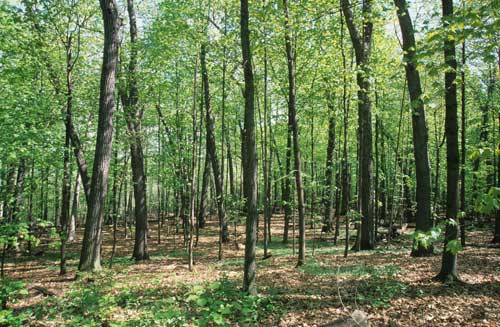Dry-Mesic Woods
What are dry-mesic woods?
In dry-mesic woods, sometimes referred to as central hardwoods or northern hardwoods, the tree canopy is nearly complete, though disturbances such as fire, blow-downs, or timber harvests can create gaps in the canopy.

As the name suggests, the dominant trees in dry-mesic woods are species either from drier woods, such as white oak and shagbark hickory, or wetter woods, including red oak, maples, basswood, ash, black cherry, and elm.
What maintained them?
Dry-mesic woods occur on loamy soils or on steeper slopes with wind-blown silts that are rich, but relatively thin. Moderate soil moisture and infrequent disturbance allowed many species to thrive in this community type.
Over time, however, selective harvesting of oaks, with little or no attention focused on bringing them back, has caused a shift in this community toward fewer oaks and more maple, basswood, ash and elm.
How do I recognize them?
Dry-mesic woods are very common. Dry-mesic woods dominated by oak and hickory are typically found on south-facing slopes on the middle- to upper-slope. Dry-mesic woods dominated by oak and cherry, on the other hand, are found on north-facing slopes on the middle- to upper-slope.
Oak-elm-dominant woods are found equally distributed between south- and north-facing slopes on the middle- to lower-slope.
What other plants and animals are present in dry-mesic woods?
Wildflowers and other herbaceous plants in these woods are diverse, including jack-in-the-pulpit, enchanter’s nightshade, large-flowered bellwort, interrupted fern, lady fern, tick-trefoils, lopseed, wild geraniun, and hog peanut.
Common animals include the Acadian flycatcher, cerulean warbler, hooded warbler, Louisiana waterthrush, whip-poor-will, wood thrush, worm-eating warbler, black rat snake, timber rattlesnake, ornate box turtle, wood frog, and woodland vole.
